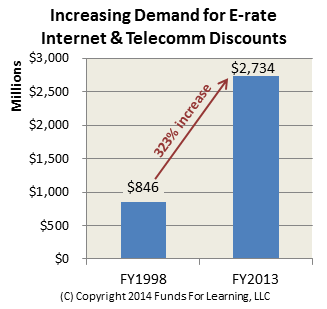America’s students and library patrons need more E-rate support. The FCC set the funding level at $2.25 billion back in 1997. A lot has changed since then – like the demand for Internet access and telecommunications discounts which has increased 323% in schools and libraries. It is definitely time to increase the E-rate funding cap. An annual cap of $6.8 billion would be great, but at least doubling the fund to $4.5 billion would be a good start.
|
|
But more funding alone is not the answer. Increasing the cap and leaving the existing priority system in place does not address the long term challenges facing the program. In fact, more money alone is likely to exacerbate the situation by encouraging and rewarding applicants to game the current FCC priority rules. This week EdLiNC met with FCC staff to discuss E-rate reform. EdLiNC expressed the need to increase the E-rate funding cap and argued that unless more funds are infused into the E-rate program, it is “…impossible to provide any Priority II support henceforward…” |
I agree with EdLiNC’s desire to increase the fund, but I disagree with their assessment regarding internal connections. The days of a two-tier priority system are over, or soon will be. Whatever service(s) the FCC defines as Priority 1 is likely to be the only priority of the program. This is because of the explosive growth in the demand for Priority 1 services. It grew 4% in FY2011, 9% in FY2012, and 13% in FY2013. If this accelerating growth continues, demand for Priority 1 discounts could reach close to $5 billion by FY2016. (NOTE: the FY2016 filing window is only two years away.)
At a fundamental level, I think the Priority system is a failure. It doubles the time necessary for USAC to issue funding decisions; it routinely denies requests for all but a small percentage of schools; it adds avoidable layers of complexity, such as the 2-in-5 rule; and, in a cruel twist, it places greater priority on funding wealthy schools over the needs of poor and rural schools.
To address this, the E-rate program needs more money along with a reform effort that takes the program back to its technology-neutral roots and proper priorities: providing money to all schools and libraries, and doing so on a sliding scale of discounts designed to provide the highest levels of support to the neediest schools, particularly those in rural America.
Funds For Learning has submitted a proposal to the FCC that outlines how this can be done with minimal change and disruption to the current program structure.
- Increase the funding cap to $4.5 billion to better meet the needs of applicants
- Keep the current discount rate and eligible services list to minimize disruption
- Eliminate the FCC Priority rules to simplify the application process
- Allow applicants to set their own funding priorities to encourage cost-effective choices
- Set a fixed filing window to promote planning and predictability
Our proposal is detailed. It even includes the specific changes necessary to the Code of Federal Regulations. (See Exhibit A of the Reform Coalition Comments.) If you have not read it yet, please take the time to do so. And then let’s talk. I am on Twitter (@jdharrington) or available via email.
It is time to increase the E-rate fund and to reform the program. Will you join me?

